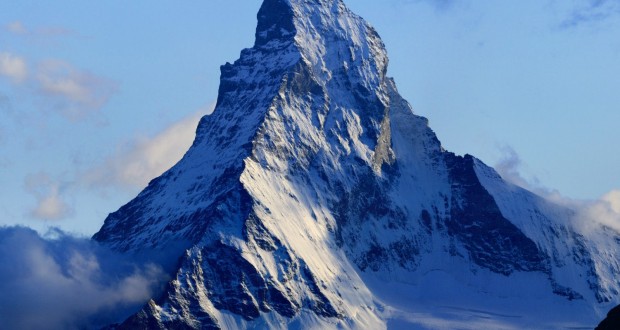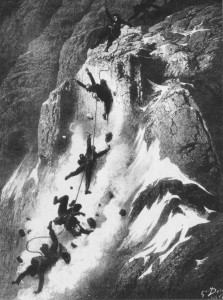As you may already know Matterhorn is Switzerland’s most famous mountain. The Matterhorn, which stands over the town of Zermatt, is nearly 4478 meters high and is the tenth highest mountain in Switzerland and one of 48 Swiss peaks that is above 4000 meters.
The Matterhorn is first mentioned in mediveal documents as “Mons Slivus”. The name later mutated into “Mons Servinus” and “Mons Servin”, and finally became “Cervin” in French and “Cervino” in Italian. The origin of the name is believed that it is from the Latin word “silva” meaning forest and Italian word “cervo” meaning stag. The Matterhorn was first referred to in writing as “Mont Cervin” in 1581, and later also as “Monte Silvio” and “Monte Servino”. The German name “Matterhorn” first appears in the year 1682. The name Matterhorn is from the German word Matte meaning “meadow” and horn meaning “peak.” The “meadow” is probably reffering to the grassy extended valley under the Gornerschlucht gorge, which has now been almost completely covered by the village of Zermatt. Just like the word means Matterhorn is roughly chiseled pyramid with exquisite nature.
The history of Matterhorn dates back to July 14th, 1865 when the Whymper team ascent the most common route today, the Hornli Ridge. It cost four out of seven alpinists lives but changed the region forever. Until then it has been an isolated mountain. The rope that connected Edward Whymper and father and son Taugwalder from Zermatt to the rest of the unfortunate rope group, and which broke during the descent, is displayed in the Matterhorn Museum alongside other relics of the first ascent. The Matterhorn became world famous, and ambitious mountaineers aspired to climb it.
The second ascent came only three days after the first, on July 17th 1865, from the Italian side. The climbing accomplishments continue into modern day with such achievements as Swiss Guides Arnold and Graven completeing two complete traverses, covering all four ridges in 19 and a half hours.
In 1995 a 33 year old Italian named Bruno Brunod set the record for the fastest ascent reaching the summit in 3 hours, 14 minutes and 44 seconds. It is actually 45 hours quicker than the original summit expedition. In 1990 Kilian Jornet broke the record by 22 minutes quicker. People say he approached the record like a highly skilled surgeon. He picked the best line, the best time of the year, the perfect weather conditions, and the best support crew.
There are other notable ascents such as the first woman, Lucy Walker in 1871, first ascent of the North Face in by F. and T. Schmid in 1931 and many more. But with all those people conquring the might Matterhorn, over 500 people have died climbing it since 1865’s tragic accident. Deaths are now about 12 annually and most are due to falls, inexperience, underestimating the mountain, bad weather, and falling rocks.
Even today the ascent of Matterhorn is very challenging and can only be achieved by expert mountaineers with excellent equipment and a competent guide.


